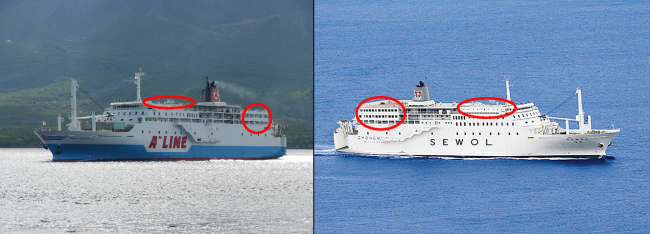[Ferry Disaster] ‘Overload, massive extension might have caused disaster’
By Korea HeraldPublished : April 20, 2014 - 20:21
The illfated ferry Sewol was overloaded and its crew seemed to have broken several other safety guidelines, which could have been the cause of the sinking on April 16, insiders suggested Sunday.
The 20-year-old vessel was reportedly renovated in 2012, after it was purchased from a Japanese ferry company. Two cabins were added to the back, possibly making it top-heavy, experts claimed.
Though it is not illegal to extend a ship vertically, it could exert greater weight and pressure on the vessel, experts say. In the Sewol’s case, the ship’s capacity was increased by 14 percent and is believed to have become 239 tons heavier than before.
“Because the ship was heavier, there are chances that the crew loaded less ballast water, which is needed to balance the ship. This may have made the ship unable to recover from the initial tilting,” a Korean Register of Shipping official said in an interview.
“If the top becomes heavier, you need to add more weight to the bottom to make it steady. But I don’t think that was the case with the Sewol,” said Park Soo-han, CEO of KCC Corporation, a shipping parts company.
The 20-year-old vessel was reportedly renovated in 2012, after it was purchased from a Japanese ferry company. Two cabins were added to the back, possibly making it top-heavy, experts claimed.
Though it is not illegal to extend a ship vertically, it could exert greater weight and pressure on the vessel, experts say. In the Sewol’s case, the ship’s capacity was increased by 14 percent and is believed to have become 239 tons heavier than before.
“Because the ship was heavier, there are chances that the crew loaded less ballast water, which is needed to balance the ship. This may have made the ship unable to recover from the initial tilting,” a Korean Register of Shipping official said in an interview.
“If the top becomes heavier, you need to add more weight to the bottom to make it steady. But I don’t think that was the case with the Sewol,” said Park Soo-han, CEO of KCC Corporation, a shipping parts company.


Some suggest that the Sewol was loaded with heavier vehicles and cargo than initially reported, which could have posed a huge blow to the sinking ship.
According to the radio correspondent log, the Sewol reported 450 passengers, 150 vehicles and 657 tons of cargo to the Korea Shipping Association. After the accident, the company revealed the actual numbers were 477 passengers, 124 passenger cars, 22 1-ton trucks, 34 cargo trucks of more than 2.5 ton-capacity, and 1,157 tons of cargo.
The Sewol had a legal capacity of 921 passengers, 180 vehicles and 154 regular cargo containers.
However, heavy trailer drivers carrying more than 30 tons of materials each, said the actual freight could be even heavier.
“Heavy vehicles and their loads weren’t examined before they were loaded on the Sewol,” another truck driver told reporters. “Because the Sewol is lax when it comes to overloading, many cargo owners prefer taking the Sewol than to drive all the way to Mokpo in South Jeolla Province and take a ship there,” he added.
Such heavy cargo were not properly tied down, causing the containers to move around the ship right after the vessel had tilted. This eventually caused the ship to tip over, insiders say. Some allegedly heard containers fall and roll over.
“If this is true, then the cargo might have upset the weight distribution. It could have accelerated the tipping over process,” Professor Lee Sang-yoon of Pukyung National University said in an interview.
Some point out that the loosened government regulations on aging ships may have contributed to the issue.
“In Japan, such large vessels are recommended to be discarded within 10 years. But in Korea, the government deregulated the age to 30 years in 2009, after constant appeals from vessel owners. If ships are old, there are higher chances of accidents,” an insider said.
By Bae Ji-sook (baejisook@heraldcorp.com)
-
Articles by Korea Herald



![[AtoZ into Korean mind] Humor in Korea: Navigating the line between what's funny and not](http://res.heraldm.com/phpwas/restmb_idxmake.php?idx=644&simg=/content/image/2024/04/22/20240422050642_0.jpg&u=)

![[Exclusive] Korean military set to ban iPhones over 'security' concerns](http://res.heraldm.com/phpwas/restmb_idxmake.php?idx=644&simg=/content/image/2024/04/23/20240423050599_0.jpg&u=20240423183955)

![[Herald Interview] Why Toss invited hackers to penetrate its system](http://res.heraldm.com/phpwas/restmb_idxmake.php?idx=644&simg=/content/image/2024/04/22/20240422050569_0.jpg&u=20240422150649)
![[Graphic News] 77% of young Koreans still financially dependent](http://res.heraldm.com/phpwas/restmb_idxmake.php?idx=644&simg=/content/image/2024/04/22/20240422050762_0.gif&u=)







![[Exclusive] Korean military to ban iPhones over security issues](http://res.heraldm.com/phpwas/restmb_idxmake.php?idx=652&simg=/content/image/2024/04/23/20240423050599_0.jpg&u=20240423183955)



![[Today’s K-pop] Ateez confirms US tour details](http://res.heraldm.com/phpwas/restmb_idxmake.php?idx=642&simg=/content/image/2024/04/23/20240423050700_0.jpg&u=)